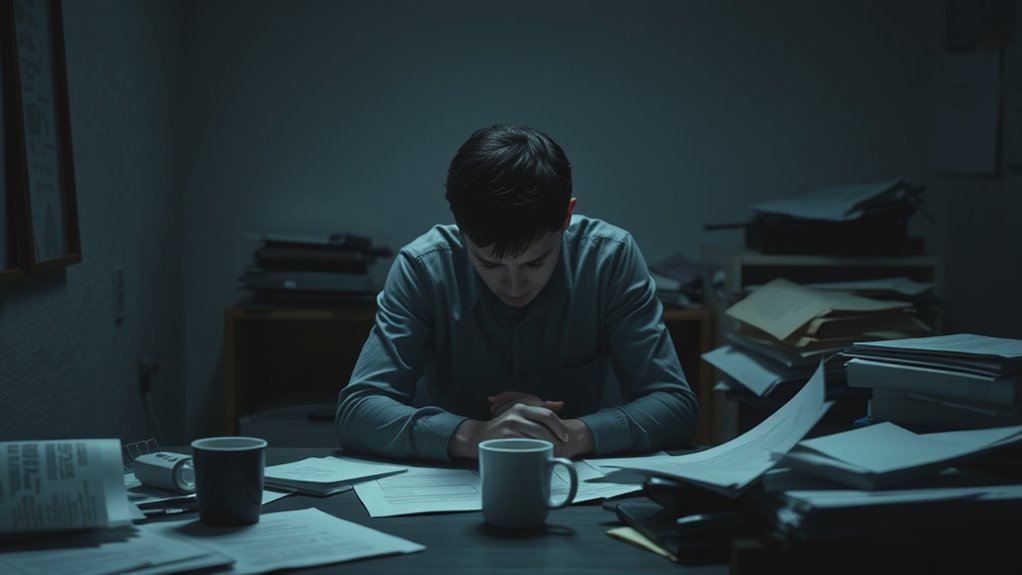To recognize depression signs, notice if you’re feeling sad, hopeless, or empty for weeks, and if these emotions make everyday tasks difficult. Watch for physical changes like sleep or appetite shifts, social withdrawal, or difficulty concentrating. If symptoms last longer than a few weeks or seriously impact your life, it’s time to seek professional help. Staying aware of these signs and when to act can make a big difference in your recovery journey.
Key Takeaways
- Persistent feelings of sadness, hopelessness, or emptiness lasting more than a few weeks may indicate depression.
- Watch for physical changes like sleep disturbances, appetite shifts, or withdrawal from social activities.
- Difficulties in daily functioning, such as decreased motivation or focus, suggest the need for assessment.
- Differentiate between temporary sadness and clinical depression by duration and impact on daily life.
- Seek professional help if symptoms persist or interfere with work, relationships, or self-care routines.
Common Emotional Indicators of Depression

Depression often manifests through a range of emotional signs that can be subtle but impactful. You might notice persistent feelings of sadness, hopelessness, or emptiness that linger long after the cause has passed. These emotions can make everyday tasks seem overwhelming, and you may find yourself withdrawing from social activities or loved ones. Recognizing these signs is the first step toward seeking help. Employing coping strategies like journaling, mindfulness, or talking with trusted friends can ease emotional distress. Additionally, reducing stigma around mental health encourages openness, making it easier for you to discuss your feelings without shame. Understanding these emotional indicators helps you take early action and fosters a supportive environment for recovery. Being aware of emotional signs can help you identify depression sooner and seek appropriate support.
Physical and Behavioral Changes to Watch For

You might notice physical and behavioral changes that signal depression, even if they seem unrelated to your mood. Sleep disturbances, such as insomnia or oversleeping, are common signs. You might find yourself waking up feeling exhausted or struggling to fall asleep at night. Appetite changes are also typical—either losing interest in food or overeating, leading to weight fluctuations. These shifts can happen suddenly or gradually and often persist over time. You may also notice yourself withdrawing from social activities or neglecting personal care routines. These changes can be subtle but are important signals that your mental health needs attention. Recognizing these physical and behavioral signs early can help you seek help sooner and manage depression more effectively. Additionally, understanding regional mental health resources can provide targeted support tailored to your location.
How Depression Affects Daily Functioning

Physical and behavioral changes can noticeably impact your daily routine, making even simple tasks feel overwhelming. Depression can cause you to struggle with focus, motivation, and energy, affecting work, relationships, and self-care. You might find it hard to complete chores or stay organized. Recognizing these impacts is essential for seeking appropriate treatment options, which could include therapy, medication, or lifestyle adjustments. Developing effective coping strategies, like establishing routines or reaching out for support, can help you manage daily challenges. Engaging in well-being practices such as regular exercise or mindfulness can also support your recovery. Remember, depression’s effects on your functioning are common, but help is available. Addressing these difficulties early can improve your quality of life and restore your ability to engage meaningfully in everyday activities.
Recognizing the Difference Between Temporary Sadness and Clinical Depression

While feeling sad or down at times is a normal part of life, it’s important to distinguish these temporary emotions from clinical depression. Temporary sadness often results from specific events and resolves with time, while depression affects your overall emotional resilience. To tell the difference, consider these factors:
- Duration: Temporary sadness usually lasts a few days, whereas depression persists for weeks or longer.
- Impact on daily life: Depression substantially hampers your ability to work, socialize, or enjoy activities.
- Mood fluctuations: Temporary moods can change quickly, but depression causes a persistent low mood and feelings of hopelessness.
- Home theatre projectors can sometimes be used to create a calming environment that helps manage mood swings.
Recognizing these signs helps you understand when sadness is part of normal mood fluctuations and when it might indicate a deeper issue requiring attention.
When and How to Seek Professional Help

Recognizing when to seek professional help is essential if feelings of sadness or hopelessness persist beyond a few weeks or interfere with your daily life. If you notice these signs, consider exploring therapy options like cognitive-behavioral therapy or medication. Seeking support from a mental health professional can provide guidance, coping strategies, and relief. Don’t hesitate to reach out if your mood impacts your relationships, work, or sleep. Remember, asking for help is a sign of strength, not weakness. You don’t have to face depression alone—therapy options are designed to meet your needs, whether through individual therapy, group support, or outpatient programs. Taking this step can be critical for your recovery and well-being. Incorporating mental health awareness into your routine can also promote early detection and sustained recovery.
Frequently Asked Questions
Can Depression Occur in Children and Teenagers?
Yes, depression can occur in children and teenagers. You might notice changes in childhood mood or teenage sadness that last longer than usual or affect daily activities. Kids and teens may seem more withdrawn, irritable, or lose interest in things they once enjoyed. If you see these signs, it’s important to seek help early, as depression in young people is treatable with the right support and intervention.
Are There Specific Risk Factors for Developing Depression?
You’re at risk for developing depression if you have a genetic predisposition or experience significant life stressors. A family history of depression can increase your vulnerability, while stressful events like loss, breakup, or financial struggles can trigger symptoms. Combining these factors makes you more susceptible. Being aware of these risk factors helps you recognize early signs and seek help promptly, improving your chances of managing depression effectively.
How Long Should Symptoms Last Before Seeking Help?
You should seek help if your symptoms persist for at least two weeks, as this duration threshold often indicates a need for support. Symptom persistence beyond this point can considerably impact your daily life. Don’t wait until your condition worsens; early intervention can make a difference. If you notice ongoing feelings of sadness, loss of interest, or fatigue lasting over two weeks, it’s time to reach out to a mental health professional.
Can Depression Be Cured Without Medication?
About 80% of people find therapy effective in managing depression, and many can recover without medication. While medication can help, alternative treatments like therapy, lifestyle changes, and support systems often prove effective. You might consider these options first, especially if symptoms are mild. Remember, seeking professional guidance helps determine the best approach tailored to your needs, ensuring a path toward recovery that may not require medication.
What Are the Side Effects of Depression Treatments?
Treatments for depression can have side effects, depending on the method you choose. Medication impact varies; some people experience nausea, weight changes, or sleep disturbances. Therapy side effects are usually less severe but may include emotional discomfort or temporary worsened feelings. It’s important to discuss these potential treatment side effects with your healthcare provider to find the best approach for you, minimizing risks and ensuring effective support on your recovery journey.
Conclusion
Think of your mental health like a garden; neglecting signs of depression allows weeds of sadness and fatigue to take over. By recognizing emotional, physical, and behavioral signals early, you can tend to your well-being before things become overgrown. Don’t wait until it’s too late—seeking help is like pulling out those weeds and nurturing your mental garden back to health. Remember, you’re not alone, and help is there to guide you toward brighter days.









